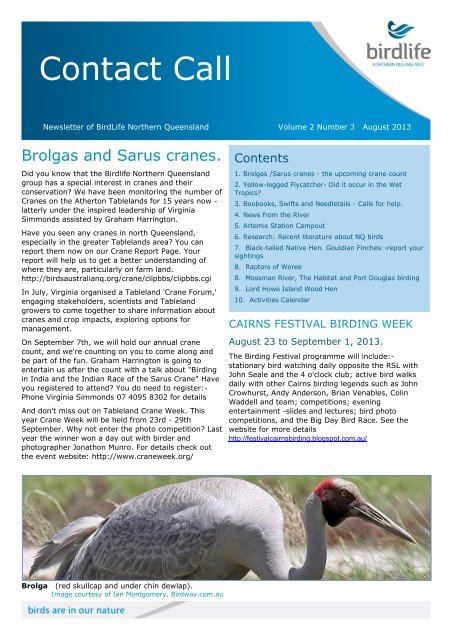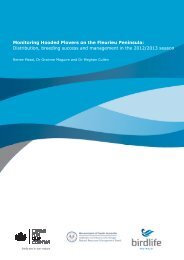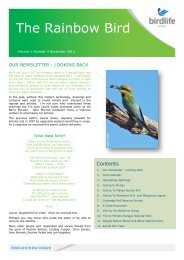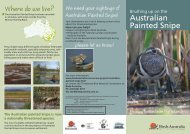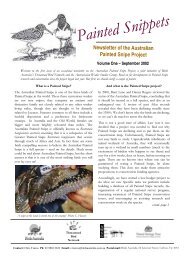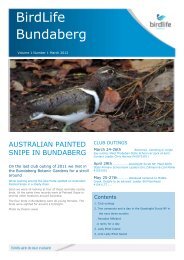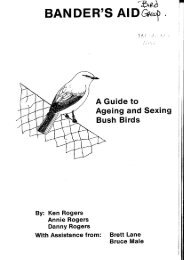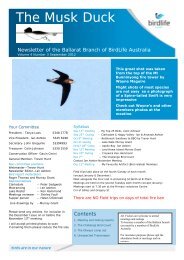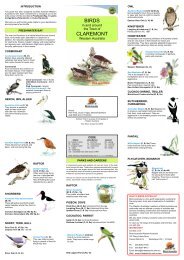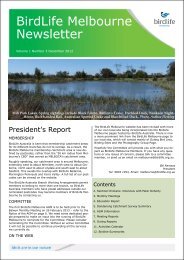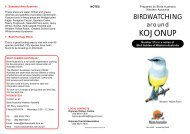Contact Call - Birds Australia
Contact Call - Birds Australia
Contact Call - Birds Australia
You also want an ePaper? Increase the reach of your titles
YUMPU automatically turns print PDFs into web optimized ePapers that Google loves.
<strong>Contact</strong> <strong>Call</strong>The Annual Atherton Tableland CraneCountA poem by Virginia SimmondsCounting cranesOh what fun.First there're noneBut wait, here comes one.Will it land?No it's too shy, so on it goes.What are those dots on the horizon ?Heading this way and now they're calling.Circling once, circling twiceLanding gear dropped and so elegantly fallingOut of the sky.Touching down, folding wings calling.Still more coming in fives and sixesNow a lull: let's have tea.Out with the thermos and the biscuits.Hurry hurry here comes a big flockI'll count this group, you count that.I got fifty, and I got eight.Were they Brolgas or were they Sarus?Someone help the recorder to get it down straight.Sarus cranes flying over.Image courtesy of Ian Montgomery, Birdway.com.auAnnual Crane Count 7th SeptemberPlease note all members and friends and interestedparties that this year we are going to trial an all daycrane counting in the paddocks and then at theroosting sites. You could register for one or other orbetter still for the full show. Let me know if you willalso join us in rounding off the day with dinner andtallying the numbers and a very interesting slide showof Sarus cranes and other creatures taken by GrahamHarrington on his trip to India earlier this year. Phoneme: Virginia Simmonds 07 4095 8302Brolga or Sarus Crane?Can you tell the difference?BrolgaRed 'skull- cap'Sarus craneRed on head extendsdown to its neckSarus? Brolgas? Say no I.D.Can't be sure in this light you see.They're coming in hundreds.Oh spread out do please.Small 'dewlap' underchin, like a knotted scarfGrey or blackish legsNo dewlap presentPink to reddish legsTailing off; light fading, two late comersGuided in by the sound from the ground.Too dark to see,Lets off to our watering hole and somethingto eat.We'll find out the total for all the groups work.BrolgaSarus CraneImages courtesy of Ian Montgomery, Birdway.com.auAugust 2013 3
Birdlife Northern QueenslandYellow-leggedFlycatcher – Did itoccur in the WetTropics?The Yellow-legged Flycatcher Microeca griseoceps mayhave existed on the Atherton Tableland and nearbyareas up until at least the 1960’s and possibly until themid 1980’s. There are persistent reports in theliterature by competent observers from that time.Are these misidentifications i.e. Pale-yellow Robinmisidentified as the flycatcher? After all the Robin hassimilar yellow legs. However, considering the numberof people who have claimed it, and their ability toidentify birds correctly, one is inclined to say "no".Yellow-legged Flycatcher:- Note the plain face andbi-coloured bill.Images courtesy of Ian Montgomery, Birdway.com.auTwo specimens were supposedly taken, one from theHerbert River in 1874 probably by E.P. Ramsay andnow in the <strong>Australia</strong>n Museum, and the other fromWondecla on the southern Atherton Tableland by A.F.Austin on 30.9.44. The latter was presented to the<strong>Australia</strong>n Museum but only the label remains reading“destroyed, worthless 1.4.47”. Both men were in eacharea at those times. (Boles 1980)P.A. Bourke and A.F. Austin (Bourke and Austin 1947)during an 18 months residence on the AthertonTableland from 1943–45, claim to have encountered itapparently fairly frequently. S.R. White (1946) duringa 20 month residence in NE Qld recorded it from the‘lower Barron River’ and from ‘jungle’ to the north ofCairns and at Mossman. J.A. Bravery (1970) during a20 year residence near Atherton described it as a “rareresident in rainforest and wet sclerophyll”. B.J. Wallace(Noske & Sticklen 1979) watched a pair for over fourhours, 6 km north of Malanda in January 1967. Inmost cases, these observers mention the distinctivefeeding habits which distinguishes it from other similarspecies including the Pale-yellow Robin, inrainforest/wet sclerophyll habitat.Later, P. Nagle (1987) while banding birds 5 km southeastof Ravenshoe (probably about 1986) netted a birdwith "distinctly bright yellow legs, grey head and whitethroat, with lower bill lighter in colour than its upperbill", features "which were not consistent with PaleyellowRobins" which he had been netting.Most of these people were competent observers andwould have known the Pale-yellow Robin well withwhich less competent observers sometimes confusethe flycatcher. However, some doubt exists withRamsay's record as there are known problems with thelabelling of his specimens as well as those early onesfrom the <strong>Australia</strong>n Museum. (Schodde 1999).Pale Yellow Robin:- Note the buff lores and spot oneach side of its forehead, and all-black bill.Image courtesy of Dominic ChaplinBourke and Austin’s report is especially convincing.They wrote "We are disgusted with ourselves for ourfailure to find the nest and eggs of this species. For atime we considered it to be E. capito, which itsomewhat resembles in the poorly-lit scrub. When wedid realise its identity we failed to find it nesting.4 August 2013
<strong>Contact</strong> <strong>Call</strong>Apart from size and colouration, which, at best, are afaulty guide in the field, the *Little Yellow Robin isdistinguishable from E. capito and E. leucops by itshabits rather than its habitat. We found it occupyingboth dense scrub and scrub/open forest borders, theborders being the usual haunt of the other twomembers of the genus. However, the Pale-yellowspends much of its time on the ground, and is arelatively quiet feeder, whilst the Little Yellow is almostcontinuously on the move amongst the vine-cladbranches, hunting up insects which it takes on thewing. Its call note uttered with scarcely a break whileit is feeding, is a rather grotesque parody of the pipingof E. australis...."This is a very accurate description of the Yellow-leggedFlycatcher. They go on to say of the Pale-yellow Robin"This species was more common in the Evelyn scrubsthan elsewhere..."Bravery (1970) says "*Little Yellow Flycatcher(Microeca griseoceps) – Rare resident in rainforest andwet sclerophyll, Somewhat like flavisgaster (LemonbelliedFlycatcher) except in feeding habits which arelow in canopy and in outer foliage in wet sclerophyll..."He also records the Pale-yellow Robin as a commonresident in rainforest.An occasional report of the Yellow-legged Flycatchersin the Wet Tropics is still made but all sightingsinvestigated have been Pale-yellow Robins. Confusionoccurs mostly because the Robin has similarly colouredlegs. Hanzab does not give differences betweenYellow-legged Flycatcher and Pale-yellow Robin,concentrating only on those species within theflycatcher's far northern Cape York Peninsula range. Isit worth keeping an eye open for the flycatcher in theWet Tropics in case there is a remnant population stillexisting e.g. on the Atherton Tableland? If so thefollowing may help —The Yellow-legged Flycatcher is largely arboreal,feeding actively in a flycatcher manner, foragingthrough branches and foliage and often takinginsects on the wing. It has grey upperparts,especially on the head; pale-lemon underparts;whitish-grey throat; bright yellow legs; dark greyupper mandible and cream to yellow lowermandible.JOIN US ON FACEBOOKIt is a Yellow-legged Flycatcher IF –1. It spends most of its time high in the rainforestcanopy2. It is continually on the move and usually quitevocal3. It feeds actively on the wing often sallying in shortfluttering flights4. It has a bi-coloured bill5. It has a plain dark-grey face without a spot oneach side of its foreheadIt is a Pale-yellow Robin IF –1. It spends nearly all of its time in the lower layer ofthe rainforest2. It is quiet and unobtrusive, sitting for minutes on aperch or tree trunk (often sideways)3. It often drops to the ground to take prey4. It has an all-black bill5. It has buff lores and spot on each side of itsforeheadNote that both Yellow-legged Flycatcher and PaleyellowRobin have yellow legs. The Lemon-belliedFlycatcher inhabits more open forest and has blacklegs.*The Yellow-legged Flycatcher has had severalcommon names over the years e.g. Little Yellow Robin(Eopsaltria kempi) (1926 RAOU checklist), Little YellowFlycatcher & Yellow-footed Flycatcher (Microecagriseoceps).ReferencesBoles, W.E., 1980 A Notable Record of the YellowleggedFlycatcher <strong>Australia</strong>n <strong>Birds</strong> 15:1:12 1980Bourke. P.A. and Austin, A.F., The Atherton Tablelandand its Avifauna. Emu 47:87–116Bravery, J.A., 1970 The <strong>Birds</strong> of the Atherton ShireEmu 70:49–63Nagle, P., 1987 Yellow-legged Flycatcher Reportedfrom the Atherton Region of North Queensland,Sunbird 17:2–31Noske, R.A. and Sticklin, R. 1979 Nest and Eggs of theYellow-legged Flycatcher Emu 148–49Schodde, R. & Mason, I.J., 1999 The Directory of<strong>Australia</strong>n <strong>Birds</strong> Passerines CSIRO, Collingwood, VicWhite, S.R., 1946 Notes on the Bird Life of <strong>Australia</strong>'sHeaviest Rainfall Region Emu 46:81–122Written by Lloyd NielsenAugust 2013 5
Birdlife Northern QueenslandBoobook, but which?Latham's snipe:Decisions make amockery ofenvironmental lawsIn a recent Birdlife <strong>Australia</strong> Media Release (24 July2013 http://www.birdlife.org.au/media/wetland-promises-mustbe-kept/)it was reported that two poor decisions maybe all it takes for Latham's Snipe to end up threatenedwith extinction under current environmental law.Boobook owls have been occasionally sighted/heardalong Lake Morris Road since Aug 2011 until Feb 2013.I took this photo on Dec 6th 2012. It is wonderful tosee this owl around Cairns. I think this particular birdis possibly a Red Boobook. I am curious about whatreaders think.Mikey KudoFork-tailed Swifts andWhite-throatedNeedletailsLetter to Birdlife Northern QueenslandG'day Nth Qld BirdlifeI have been assessing the total Oz population of ForktailedSwifts and White-throated Needletails for 20-30years now and was wondering if your members wouldhave records of either species from the last seasonthat I could add to my database. I am also interestedin older records if anyone has them and has the timeto send them to me.I publish a summary annually on the Birding-Aus listand have started sending a copy to each contributorwhose e-mail address I have. This summary alsoindicates how many records each observer sends in.Hope you can help from your part of the country.Many thanksMike TarburtonEmail: tarburton.m@optusnet.com.auMoyne Shire Council has decided to allow a subdivisionon the Powling Street Wetland Complex in Point Fairy,an internationally significant site for Latham’s Snipe. Itfollows an earlier decision by the federal governmentto approve the development, with minimalconcessions, in breach of international treaties.The Powling Street Wetlands is the most importantknown site in <strong>Australia</strong> for the nationally listedLatham’s Snipe. ‘Nowhere else in <strong>Australia</strong> doLatham’s Snipe congregate so regularly in such largenumbers,’ said Samantha Vine, BirdLife <strong>Australia</strong>’sHead of Conservation. ‘It’s a significant feeding androosting ground to fuel their journey back to Japan —and far too important to sacrifice for a handful ofhouses.’‘It is a perfect example of why <strong>Australia</strong> needs a meritsreview for decisions made under the EnvironmentProtection and Biodiversity Conservation Act,’ she said.RED-TAILED BLACK COCKATOO ATYORKEYS KNOBImage courtesy of Kelvin Turner6 August 2013
<strong>Contact</strong> <strong>Call</strong>Herons become more secretive as they becomeoccupied with nesting through spring and earlysummer. It takes about a hundred days for the youngchick – generally only one - to fledge the nest aroundChristmas time. Two pair of heron must have beensuccessful in fledging a chick last season as recentlytwo youngsters have taken up residence in the narrowconfines of Barratt Creek - a tidal tributary to theDaintree River.On a recent cruise, one of these juveniles wasobserved begging the parent for a regurgitated meal.For more than five minutes the youngster put on anextraordinary performance - reminiscent of a toddlerhaving a tantrum - including a strange overhandrowing motion of the wings. Eventually the adult heronflew away with the youngster’s puerile behaviourunrewarded. The youngster is about ten months oldafter all…News from the RiverTIME OF THE ‘KING’... & A FEWOVERGROWN LIZARDS…Oh, yeah. I nearly forgot…reptiles are also especiallygood during the winter months. In the cold conditions,Green Tree Snakes are commonly found out on theouter branches over the river seeking warmth from thesun. Likewise Saltwater Crocodiles are also commonlyseen, particularly on a low tide on sunny days,emerging from the cool water mid-morning to enjoythe sunshine.This is a regular quarterly column reporting wildlifeobservations on the Daintree River by the ‘DaintreeBoatman’, Murray Hunt.Winter cruises are often quite chilly, sometimes a littledrizzly, and often initially misty…but if I was a weatherreporter my summation of winter cruises would be,“Early surreal heavy mist clearing to bloody beautiful!”Winter is the time of year when brave cruisepassengers venturing out from their cosy slumber aremost rewarded with fresh, clean, crystalline vistasafter the rising sun slowly dissipates the lingeringblanket of mist.Adult Great-billed Heron. Image courtesy of GeoffSmith. All rights reserved.Winter is also the season when passengers are mostlikely to be rewarded with crippling sightings of the‘King’ of the river, the Great-billed Heron. May, Juneand July is the time of the year that this bird is at itsmost relaxed and repeatedly during this periodpassengers have obtained close, extended views ofthis normally shy heron. An incredible 85% of cruisesduring this time have observed at least one heron.Some passengers have also been lucky enough towitness this heron bellowing its extraordinary call thatis akin to an angry bull or an unhappy puppy. Toproduce this call the heron raises its head skyward,inflates the cheeks and neck, and then propels its callforth by pulling its head back to the body like a verticalharpsichord. In the next month or two, Great-billedImmature heron. Image courtesy of Jacqueline Phillips.All rights reserved.August 2013 7
Birdlife Northern QueenslandArtemis StationGolden-shoulderedParrot Campout22 - 27 MAY 2013Excitement was in the air when members fromTownsville and Northern Queensland branch convergedon Artemis Station for a joint campout in May. I wasjust one of the many members who had been lookingforward to Awesome Artemis for weeks beforehand.Owners, Sue and Tom Shephard, made us mostwelcome and shared with us, not only their property,but also the best locations to spot the elusive GoldenshoulderedParrots. One hundred and forty ninespecies of birds were sighted during the camp out. Thistrip report is a combined effort. Thanks go to my coauthorsfor sharing "What was the best part of theArtemis campout?".Virginia: The Golden-shouldered Parrots! Their colourwas so much more vivid and startling than I expected.Murray: Revisiting some of my favourite bird watchingsites, and showing attendees an assortment of greatbirds such as finches, owls, parrots and raptors.Ceri: Observing the rare and threatened GSP's,feeding and caring for their young in the termitemound nests. Having listened to Gabriel Crowley'sfascinating talk about the plight of the parrots at theApril meeting, actually seeing the birds in real life wasjust awesome. They are stunning!Darlene: The hospitality of Sue and Tom and theirwillingness to share their local knowledge of GoldenshoulderedParrots and their property with us.Midge: the unmistakable <strong>Australia</strong>n-ness of thecountry, especially the Blue Winged and LaughingKookaburras having a shout-off at dawn with thegalahs chipping in.Don: Marina Plains by day and night; a young GoldenshoulderedParrot poking its head out of the entranceto its termite-mound nest and, after a long wait, theadult pair flying in to feed it.Murray: It was great to get out in the country, andonce again experience the sights, sounds, andhospitality of the Cape.Alison: the expert knowledge, patience andwillingness of group leaders and others guiding us andshowing us the birds.Golden shouldered parrot.Image courtesy of Scott TempletonMidge: the thrill of driving around another corner andseeing another billabong covered with water lilies andbirds - and the spear gates - who could forget them.Alison: Seeing the Jacana on our visit to the LotusBird Lodge lagoon. To have such long toes, and I lovetheir delicate 'flipper' walk.Ceri: Catching sight of Doug dance when he found theOwlet nightjar.Midge: The night spotting was wonderful. We saw somany night birds and saw them often. Barking owls,nightjars, frogmouths and barn owlsCeri: Our sunset drinks at Marina Plains and theglorious golden hues of the sky, followed by picnicdinner watching the full moon rise. As if that wasn'tenough, we then had the best spotlighting drive in mylife - I've never seen that many owls and nightjars inone night. Never!Pippy: The Cooktown orchids in full display in the VineThicket.Ceri: Seeing Murray and Doug present that greatclosing gift to Sue and Tom, with all the groupsappreciation. A lot of thought went into finding<strong>Australia</strong>n stamps of Golden-shouldered Parrots andframing them. Good on Murray for thinking of it.And generally from everyone: The laid backatmosphere, the camping, the great weather andsunshine, and getting together with the Townsvillemob, and sharing their experience and knowledge ofthis great birding place. Special thanks to Doug andMurray, and the Shephard's for this great birdingcampout! Let's do it again.Compiled by Ceri Pearce8 August 2013
<strong>Contact</strong> <strong>Call</strong>Awesome ArtemisBirdlife members with Tom and Sue ShephardOn the lookout for Golden-shouldered Parrots.Image courtesy of Midge BellMurray presenting the gift Barn Owl, Marina Plains.to Tom and Sue.Owl image courtesy of Don FranklinIs the coast clear? A Golden-shouldered Parrot in theentrance hole to a nest in a termite mound.Image courtesy of Scott TempletonCooktown orchidsGSP termite mound.Images courtesy of Don FranklinOwlet nightjar! A new bird for Doug and a few others.The Editor has a photo of Doug's new bird dance, andmay consider sharing it for the right price.The sunset crew at Marina PlainsAugust 2013 9
Birdlife Northern QueenslandResearch:Recent (2012)literature about birds inNorth QueenslandNon-technicalChaplin D. 2012. Into the unknown. <strong>Australia</strong>n Birdlife1(4): 40-41. [Fawn-breasted Bowerbird]Eussen D. 2012. <strong>Birds</strong> of the tidal forest. <strong>Australia</strong>nBirdlife 1(2): 52-55.Maurer G. 2012. Shorebirds of the savannah.<strong>Australia</strong>n Birdlife 1(3): 42-47. [Oriental Pratincole,Little Curlew, Oriental Plover]Tarburton M 2012. Swift manoeuvres: how nesting<strong>Australia</strong>n Swiftlets beat La Nina floodings. <strong>Australia</strong>nBirdlife 1(3): 26-29. [Chillagoe]<strong>Birds</strong> of rainforest and wet sclerophyllforestAnderson AS, Reside AE, VanDerWal JJ, Shoo LP,Pearson RG, Williams SE. 2012. Immigrants andrefugees: the importance of dispersal in mediatingbiotic attrition under climate change. Global ChangeBiology 18: 2126-2134.Brothers N, Bone C. 2012. Torresian Imperial PigeonDucula spilorrhoa monitoring, population trends andspecies suitability as an indicator of environmentalchange. Corella 36: 69-75.Catterall CP, Freeman AND, Kanowski J, Freebody K.2012. Can active restoration of tropical rainforestrescue biodiversity? A case with bird communityindicators. Biological Conservation 146: 53-61.Chapman A, Kofron CP. 2012. Non-resident birds intropical wet sclerophyll forest, northeast Queensland,<strong>Australia</strong>. Tropical Zoology 25: 127-134.Savanna birdsKutt AS. 2012. Feral cat (Felis catus) prey size andselectivity in north-eastern <strong>Australia</strong>: implications formammal conservation. Journal of Zoology 287: 292-300.Kutt AS, Perkins GC, Colman N, Vanderduys EP, PerryJJ. 2012. Temporal variation in a savanna birdassemblage: what changes over 5 years? Emu 112:32-38.Kutt AS, Vanderduys EP, Ferguson D, Mathieson M.2012. Effect of small-scale woodland clearing andthinning on vertebrate fauna in a largely intact tropicalsavanna mosaic. Wildlife Research 39: 366-373.Kutt AS, Vanderduys EP, O'Reagain P. 2012. Spatialand temporal effects of grazing management andrainfall on the vertebrate fauna of a tropical savanna.Rangeland Journal 34: 173-182.Kutt AS, Vanderduys EP, Perry JJ, Perkins GC. 2012.Do miners (Manorina spp.) affect bird assemblages incontinuous savanna woodlands in north-eastern<strong>Australia</strong>? Austral Ecology 37: 779-788.Kutt AS, Vanderduys EP, Perry JJ, Perkins GC, KempJE, Bateman BL, Kanowski J, Jensen R. 2012. Signalsof change in tropical savanna woodland vertebratefauna 5 years after cessation of livestock grazing.Wildlife Research 39: 386-396.Perry JJ, Kutt AS, Perkins GC, Vanderduys EP, ColmanNJ. 2012. A bird survey method for <strong>Australia</strong>n tropicalsavannas. Emu 112: 261-266.Reside AE, VanDerWal J, Kutt A, Watson I, Williams S.2012. Fire regime shifts affect bird speciesdistributions. Diversity and Distributions 18: 213-225.Valentine LE, Schwarzkopf L, Johnson CN. 2012.Effects of a short fire-return interval on resources andassemblage structure of birds in a tropical savanna.Austral Ecology 37: 23-34.Vanderduys EP, Kutt AS, Kemp JE. 2012. Uplandsavannas: the vertebrate fauna of largely unknown butsignificant habitat in north-eastern Queensland.<strong>Australia</strong>n Zoologist 36: 59-74.Vanderduys EP, Kutt AS, Perry JJ, C PG. 2012. Thecomposition of mixed-species bird flocks in northern<strong>Australia</strong>n savannas. Emu 112: 218-226.Waterbirds & miscellaniaHoque MA, Burgess GW, Karo-Karo D, Cheam AL,Skerratt LF. 2012. Monitoring of wild birds forNewcastle disease virus in north Queensland,<strong>Australia</strong>. Preventive Veterinary Medicine 103: 49-62.Wood KA. 2012. An analysis of the movements of theSpangled Drongo in eastern <strong>Australia</strong> (late 1800s-mid1990s). <strong>Australia</strong>n Field Ornithology 29: 113-132.Compiled by Don Franklin10 August 2013
<strong>Contact</strong> <strong>Call</strong>LITERATURE INSIGHTSDrongos on the moveWood (2012) presented an analysis of Atlas andliterature records of the Spangled Drongo in eastern<strong>Australia</strong>. Drongos were present in north Queenslandthroughout the year, but Wood found evidence of asouthward migration in October and November with areturn movement in March to May, with the formerconcentrated near the coast but the latter more widelydispersed.<strong>Birds</strong> in the diet of feral catsFeral cats in north Queensland savannas preferred tocatch and eat mammals, but also consumed a range ofreptiles and birds (Kutt 2012). <strong>Birds</strong> in the weightrange of 50-100 g were preferred, a previous paperfrom the same study listing quail and button-quail asparticularly frequent in the diet. Interestingly, thesepreferences also depended on the size of the cat, catsin the 3-4 kg range being more likely to consume birdsthan those that were smaller or larger. There was alsoa hint in the data that males may be more likely toconsume birds than females.Counting TorriesThe usefulness of counting Torresian Imperial Pigeonsas they fly back from the mainland to the island theynest on in the late afternoon has been evaluated andconfirmed by Brothers & Bone (2012). They presentanalyses for islands along the north Queensland coastfrom the Low Isles near Mossman north to RockyIsland near Iron Range. Analyses of the timing of thereturn flights from 3:30 PM to dark counted in 15-minute intervals showed that about 70% of birdsreturned between 5 and 6 PM. Comparison of somehistorical (c. 1958 to c. 1988) counts with 2008 countsfor six islands (Woody, Night, Pipon, Hannah, HayIsland and Three Isles) suggest that the populationthere has been stable or increased slightly.Written by Don FranklinBirdLife Northern Queenslandwww.birdsaustralianq.orgAugust 2013 11
Birdlife Northern QueenslandBLACK TAILED NATIVE HEN518 Bird species have been recorded in our Northern Queensland region checklisthttp://www.birdsaustralianq.org/pdfs/new_checklist/06-Northern-Queensland-Bird-checklist.pdf, which isroughly defined as the area of Queensland North of a line from Ayr to Mt Isa. One of these species, perhapsrarely encountered by most of us, is the Black-tailed Native Hen. In June, I was very pleased to come acrossthis small party at the Mt Isa water treatment works. This is a species I hadn't seen for many years, my oneand only other sighting being at the exact same location in 1999. I was lucky to get a couple of shots off, ofthese curious and slightly comical hens.Contributed by Dominic ChaplinON THE LOOKOUT FOR GOULDIAN'SAt the recent BirdLife Northern Queensland evening at Port Douglas, Del Richards discussed the sixty plusGouldian Finch records and reports that he has collected over the past seven years since the first releasesfrom a captive breeding program at Mareeba Wetlands. These records are from Lakefield National Park andKowanyama in the north, to El Arish and Georgetown in the south, and west to the QLD/NT border. Recordsare from singles, to over thirty birds. Sightings of birds released at Mareeba largely haven't been documentedthrough lack of publicity and ignorance on part of the general populace. With the ongoing support of WarrenEntsch M.P., Del has produced a bumper sticker in an effort to engage the community to reporting GouldianFinches. These are available to members of BirdLife Northern Queensland from Del. A small donation wouldbe appreciated. Any assistance provided may help document the distribution of these beautiful birds, andinform our knowledge of their plight or recovery. Email Del Richards12 August 2013
<strong>Contact</strong> <strong>Call</strong>target on the back. Emerging from the twigs with itsprey, it spiralled onto the roof of my neighbour’s shedfollowed by the flock. As the gang descended, theGoshawk let go and its prey strongly flew off with thegoshawk noisily pursued in the opposite direction.White bellied sea eagleImage courtesy of Doug HerringtonRaptors of WoreeSince moving into my house in Woree in early 2008 Ihave been quite impressed with the variety of raptorsin the neighbourhood. There are many that are simplyflyovers such as White-breasted Sea-eagle, BrahminyKite, Black Kite, Square-tailed Kite, Kestrel, PeregrineFalcon and <strong>Australia</strong>n Hobby. This year the Black kitesturned up about a month before the start of the sugarcrushing season and I was surprised the other day towalk out onto my back patio and see a Black Kite andSquare-tailed Kite flying meandering lazy circlestogether about 15m above ground level. I seem to getat least one or two sightings of a Square-tailed Kiteeach year. Some of the more experienced local birderstell me that this species used to be sighted regularlyyears ago. The Peregrine Falcon and <strong>Australia</strong>n Hobbyare often seen making high speed runs through theneighbourhood in the early morning or late afternooncausing alarm among the other bird species.My neighbours have large trees in their yards whichare popular roosting spots. I have recently witnessed aWhistling Kite bring a squashed toad recovered fromAnderson Road and turn it over and consume it,leaving the skin on the back and head. The more leafytrees are often butchering refuges for Grey Goshawk,Brown Goshawk and Collared Sparrowhawks. I havenoticed that a favourite prey appears to be the SpottedDove which seems to get to an abundant populationand then the various raptors arrive and the numbersnoticeably drop.I was of the opinion until a few years ago thatCommon Mynas seemed to be immune to predationfrom raptors due to the aggressive tribal response.That was until I was driving down a Kirwan street andsaw a Sparrowhawk or Goshawk fly out of an Albiziatree and take a Myna from behind and return to itsroost unnoticed in matter of a few seconds. The mostspectacular display in Woree was the raptor call goingup and a flock of Mynas who flew into the drying twigsof a massive tree followed by a Grey Goshawktravelling feet first at speed. It caught its protestingThe interactions of the Grey Goshawk with theSulphur-crested Cockatoos are interesting. I noticedthat often predator alarm calls go up when Cockatoosapproach. I often wondered why until recently Inoticed that a Grey Goshawk flew in with about 6Cockatoos and when close enough to prey it made itsmove…albeit unsuccessfully. I have also noticed thatGrey Goshawks will torment Sulphur-crestedCockatoos by flying behind them and having a go attheir tail. I have seen a cockatoo pursue a GreyGoshawk in a similar manner.I am not sure if the Grey Goshawks are resident ornomads. The grey phase is often seen around homefor a few weeks and then they turn up at my aunt’splace about a kilometre away. I have seen the whitephase turn up for a few days and then not seen againfor some time or a white individual may later befollowed by a white pair. The Grey Goshawks appearto have mated in the neighbourhood judging by thepersistent calling over a number of days but I neverfound the nest. The Brown Goshawk and CollaredSparrowhawks seem to be passers through sincedifferent ages are seen for a few days and then leave.In late 2012 my sweet potato patch was being wasbeing ravaged by hungry rats. As I appeared on thepatio the lights came on and a surprised Barn Owl flewoff into the darkness. I never saw it again. I suspectthough that this is not the only owl species in thelocation since not long after moving in I am sure that Icould hear a Rufous Owl in the early hours of themorning calling from the nice thick tree canopies in thepark. A few weeks later I did hear a Boobook calling.Black kiteWritten by Greg BortolussiImage courtesy of Doug HerringtonAugust 2013 13
<strong>Contact</strong> <strong>Call</strong>Birdlife NQ members bird watching on the Mossman Riverwith Murray HuntUpstream, the river narrowed and became impassablebecause of fallen trees and shallow water.knowledge with fellow Birders. We glimpsed aMangrove Robin, Eopsaltria pulverulenta.Someone else spied a fast disappearing LittleKingfisher, Alcedo pusilla, but all I gleaned was a tinypatch of blue. We stayed out for about two hours andonly scraped the bottom once as the tide disappearedvery quickly. A highlight for me was a SaltwaterCrocodile, Crocodylus porosus. He seemed to be shortand very well fed and last seen scuttling away towardsa Mangrove Robin dinner. As we were returningMurray’s youthful eyes caught a Green Tree Snakesunbaking, Dendrelaphis punctulata. This was asurprise for me as I was under the wrong impressionthat snakes hibernate in the dry season.My Bird List for the two hours included:Australasian Darter Anhinga novaehollandiaeLittle Pied Cormorant Microcarbo melanoleucasBlack Necked StorkEphippionhynchusaustralisStriated HeronButorides straitus<strong>Australia</strong>n White IbisThreskiornismoluccaLittle Egret EgrettagarzettaGreat <strong>Australia</strong>nEgret Ardea albaBlack Kite MilvusmigransWhite Breasted SeaEagle HallaeetusleucogasterBeach Stone CurlewEsacus neglectusWhimbrel Numenius phaeopus<strong>Australia</strong>n Pied Oyster Catcher HaematopuslongirostrisBlack Fronted Dotterel Elseyornis melanopsCrested Tern Thalasseus bergii. This one stayed putas many took great images of the bird perched upon apost with a reflector marking it out for Boaties.Bar Shouldered Dove Geopelia humeralisSulphur Crested Cockatoo Cacatua galeritaAzure Kingfisher Alcedo azureaSacred Kingfisher Todiramphus sanctisCollared Kingfisher Todiramphus chlorisRainbow Bee-Eater Merops ornatusDusky Honeyeater Myzomela obscuraLeaden Flycatcher Myiagra rubeculaWillie Wagtail Rhipidura leucophrys……… Derivation.Greek Rhipis, fan. Oura, tail. Leucos, white. Phrys,brow. Quite fascinating to me.Yellow Oriole Oriolus flavocintus.Black Butcherbird Cracticus quoyiSpangled Drongo Dicrurus bracteatusOlive Backed Sunbird Nectarinia jugularisWelcome Swallow Hirundo neoxena28 all up for me. Thanks Murray for your dedicationand good humour. Not forgetting you lent me yourhand when the boat wobbled.Black-necked Stork.Image courtesy of Doug HerringtonCrested Tern, posing for the cameras.Image courtesy of Doug HerringtonAugust 2013 15
<strong>Contact</strong> <strong>Call</strong>The days of petrol rationing seem a distant memory tome, but had to be invoked as the storm approachedChristmas Island. Thank you so much for giving ofyour time and sharing with such knowledge Del.Clare from the Wildlife Habitat spoke very clearlyabout the various projects and wildlife rescue andrehabilitation carried on by the Habitat. Theseactivities are mostly governed by finances. Theevening was truly enhanced by the sonorous voices ofthe Bush Stone Curlew family, Burhinus grallarius,yodelling away as they dashed about their business____ at one stage actually halting proceedings.SUNDAY WALK and THEN A VISIT TOFERRERO ROAD GUIDED BY DOUG.Raincoats were donned as we met Doug in TheWildlife Habitat car park at the duly appointed hour.Another Saltwater Crocodile, Crocodylus porosus, wasspotted in the Lake heading into Port Douglas , thisone was longer and thinner than the one on Saturday.Bird List for me is as follows:Orange Footed Scrub Fowl Magapodius reinwardtGreen Pygmy Geese Nettapus pulchellusLittle Pied Cormorant Microcarbo melanoleucosCattle egret Ardea ibisIntermediate Egret Ardea intermediaDusky Moorhen Gallinula tenebrosaPurple Swamphen Porphyrio porphyria……………..what abeautiful name!Comb Crested Jacana sheltering three small chicks.Irediparra gallinaceaeSpotted Turtle Dove Streptopelia chinensisPeaceful Dove Geopelia striataForest Kingfisher Todiramphus macleayiiHelmeted Friarbird Philemon buceroidesYellow Honeyeater Lichenostomus flavusAustralasian Figbird Sphecotheres viridisBlack Butcherbird Cracticus quoyiMistletoe Bird Dicaeum hirundinaceumNot bad for about half an hour, Thanks Doug.The day was heating up as we drove a short distanceto Ferrero Road on the western side of Port Douglas. Aprivately owned and well maintained bird sanctuary iswhat I would call this dam, teeming with birds andsurrounded by lush green vegetation.Hanging over the fence with binoculars glued to eyeswe were greeted to a marvellous sight. In came anenormous flock of honking Magpie Geese, Anseranassemipalmata. They settled into the grass and began tomove in for drinks.Other <strong>Birds</strong> seen at Ferrero Rd include:Hardhead or White Eye Aythya australisPacific Black Duck Anas superciliosaPink Eared Duck Malacorhynchus membranaceusAustralasian Grebe Tachybaptus novaehollandiaeLittle Black Cormorant Phalacrocorax sulcirostrisLittle Pied Cormorant Microcarbo melanoleucosWhistling Kite Halicastur sphenurusSulphur Crested Cockatoo Cacatua galeritaMagpie Lark Grallina cyanoleucaTree Martin Hirundo nigricansFairy Martin Hirundo ariel ------- Derivation Greek,Hirundo, swallow. Ariel, sprite….how delightful.Thanks Doug for sharing these beautiful locations withus.By the time we packed up tents and headed to theBump Track in the verdant Mowbray Valley the otherBirdos had finished up. I enjoyed the history of thetrack found by Christy Palmerston and so Midge and Iheaded up and up ----- and puffed some more to getup further and yes further. Quite a steep climb for theold bullocks.Fortunately there were some excellent Non Passerinesabout at mid- morning and the windless skies were avery clear blue.Oriental Cuckoo Cuculus optatusFan Tailed Cuckoo Cacomantis flabelliformisLittle Bronze Cuckoo Chalcites minutillusRainbow Bee-Eater Merops ornatusRufous Fantail Rhipidura rufifronsNorthern Fantail Rhipidura rufiventrisVaried Triller Lalage leucomela.Another great Birding weekend organised by Doug andMurray. Roll on the next one. It is a fantastic groupand to you all, may I say how much I am enjoyingyour company and enormous bank of knowledge.Trip Report by Pippy CannonAugust 2013 17
Birdlife Northern QueenslandGIFT IDEAS FOR THEBIRDERS IN YOUR LIFEAt Ferrero Road, some Birdlife members were luckyenough to see the visiting Red-necked Avocet.Image courtesy of Doug HerringtonLORD HOWE ISLAND WOODHENClifford Frith entertained us at our May meeting andbirding weekend at Yungaburra with a superblypresented and illustrated talk about the near demiseand recovery of the Lord Howe Island Wood Hen. NowClifford's new book is available. It tells the fascinatingsuccess story of saving this amazing flightless bird.This unique large rail was on the brink of extinctionwith just 15 individuals found in 1980. The bookbegins with the discovery and ecology of Lord HoweIsland. It then details the history and evolution of theWoodhen, as well as detailing the captive breedingprogramme and the way in which the wild populationrecovered. The ecology, behaviour and breedingbiology of this unique flightless island rail are alsodiscussed. The textis accompanied bynumerousphotographs anddrawings.The Wood Hen isavailable fromCSIRO Publishingand is currently onsale for $59.95 inhardback. And as abonus, BirdLife<strong>Australia</strong> membersreceive a significant20% discount.http://www.publish.csiro.auA book, like The WoodhenOther Books: Try Andrew Isles Books online,Mary Who in Townsville or Collins at SmithfieldSubscription to Birdlife <strong>Australia</strong>, or other birdclubs, magazines or <strong>Australia</strong>n GeographicMugs with bird picturesArtworks and Photos of birds from some of ourmembers(if we named them we would surelymiss some!)Thermos flask for outingsTea towels, bags, oven mitts etc with BlueWren design from <strong>Australia</strong>n Geographic giftshopBird or nature DVDs. Try ABC shopsBirding hat.<strong>Australia</strong>n Geographic Birdwatchers JournalBirdbath (for the rich and famous):http://www.williewildlifesculptures.com.au/designs/birdbaths-bird-tables/ for the latestChelsea garden designs in birdbathsBirdfeederBird-attracting plantshttp://www.birdsinbackyards.net/http://www.sgaonline.org.au/?p=6910 orhttp://www.abc.net.au/gardening/stories/s2195321.htm for more info on plants2014 Bird CalenderA birding holiday or weekendFrom t shirts to bumper stickershttp://www.cafepress.com.au/+birdwatching+giftshttp://www.zazzle.com.au/bird+watching+giftshttp://www.birdorable.com/gifts/If you wish to receive a hard copy of“<strong>Contact</strong> <strong>Call</strong>” or “Drongo” by mail pleasecontact National Office atmembership@birdlife.org.auor phone (03) 9347 075718 August 2013
<strong>Contact</strong> <strong>Call</strong>THE PASSING OF ARNOLD MAGARRYOur very own Arnold Magarry passed away recently,aged 94 years. Arnold, together with his wife Dawnwho survives him, have been keen birdwatchers formany years. I first met Arnold in 1979 when I firstarrived in Cairns and joined the North QueenslandNaturalists Club. Arnold and Dawn held key roles inthe Club for many years, until its transition to Mabel'sMates in 2002. I will never forget the great trips andcampouts with the Nats, especially at Mt Lewis andEaster at Georgetown. Arnold will long beremembered by Cairns birders and naturalists foropenly and enthusiastically sharing his love andextensive knowledge of birding and natural historywith everyone, young and old. And in doing that, heinspired a few to take up rewarding careers inhorticulture, science and biology along the way. Thankyou Arnold. Your contribution will not be forgoten.CASSOWARY INCIDENTS CONTINUE1. Rangers were called on 30/5/2013 to inspect aninjured bird which was sighted at a banana farm inEast Feluga. The female sub adult cassowary wasfound and inspected by the vet. The bird had sustainedinjuries consistent with a vehicle strike, with damageto the pelvic and spinal areas. The bird was in poorcondition and was having trouble walking. It waseuthanased on the advice of the vet.2. A juvenile cassowary was found in a concussedstate on the side of Loyd Bell Road, Hobans Creek, on3/06/2013. The road is sealed, with a 60km/hr speedlimit, and the roadside is cleared. The bird was keptovernight by the vet, and then taken to the Garner'sBeach rehabilitation facility. The rangers will try toreunite this bird with its father (when it is fit to bereleased).Notice BoardNext newsletter deadlinePlease submit stories/news/reports by October21st.The newsletter has its own email account now:birdlifenqnewsletter@gmail.com. Articles and images canbe submitted to this account.AdvertisingAdvertisements and sponsorship help support BirdlifeNorthern Queensland. Any profit is used for educationand conservation projects. The advertisements mustbe relevant to Birdlife Northern Queensland membersand compatible with Birdlife <strong>Australia</strong> objectives andfund raising guidelines.Quarter page advertisements for 4 issues can bepurchased for $70 plus GST, or $20 plus GST for asingle issue. <strong>Contact</strong> the Editor for further information:birdlifenqnewsletter@gmail.comCALENDAR OF EVENTS 2013Come and join us. Everybody's welcome.For day trips, do bring a hat, sunscreen, lunch,refreshments/water and a folding chair.For more information about an outing or an event,contact Doug Herrington at herrinton01@bigpond.comor the leader listed.Doug Herrington, Activities CoordinatorNIGHT PARROTThe elusive night Parrot has been found thanks to theextraordinary effort and dedication of John Young.Thought to be extinct for the last 30 years or so, Johnrecently presented evidence to a scientific panel ofspecialists. On July 3rd, at a special meeting at theQueensland Museum, John presented still photos,video footage and a few feathers of the enigmaticnight parrot, a nocturnal spinifex dwelling ground bird.For more information:http://www.abc.net.au/news/2013-07-03/man-claimsto-have-filmed-the-rare-australian-nightparrot/4796342For Coming Birdlife Events and activities inthe North Queensland areavisit these websites for the latest details:www.birdsaustralianq.orgwww.birdlifetownsville.org.auFor more bird watching outings in the greaterCairns area, go to:http://cairnsbirds.blogspot.com.au/August 2013 19
Birdlife Northern QueenslandDate Time Locality Meeting place and other information Leader PhoneFri 23Aug - Sun1 Sept.CairnsCairns Festival Birding Weekhttp://festivalcairnsbirding.blogspot.com.au/Check thewebsiteSat 7Sept.Sat 7Sept.Sun 8Sept.Mon 23 -Sun 29Sept.Sun 6Oct.Fri 4 -Mon 7Oct.Tue 8 -Wed 9Oct.Sat 12Oct.Sat 2Nov.Sun 3Nov.Sun 1Dec.Sat 7Dec.10 am forday count.3pm foreveningcount.MalandaCrane Count10am Day Count: Participants will need to register well inadvance so that they can be allocated their route. Your routemap will be posted to you after registration.Evening Count: Meet at Hasties Swamp at 3.pm to beallocated counting sites.Evening Malanda Dinner and Club Meeting.Speaker – Graham Harrington on the Sarus Cranes of Indiaand other animals seen on his recent trip8 am to 1 pm MtHypipameeand theTablelandsScheduledactivitiesMalanda areaBirding Morning with Alan GillandersBowerbirds and high altitude endemics. Tumoulin State Forestfor birdlife associated with gliders taking sap from the RedStringybarks. Other birds of the tall eucalypt forest e.g.Crested Shrike-tit. Possible spotlight tours for gliders 6th or8th for a $10 donation pp. to the Tablelands National ParksVolunteers.Tablelands Crane WeekDaily Activities at the Malanda Falls Visitor Centre (open9.00am to 4.30pm)6.30am Cairns Birding Centenary Lakes with John SealeMeet 6:30am at Fresh Water Lake, Greenslopes St oppositethe Rondo TheatreYourka, nearInnot HotSpringsKoombaloomba Dam nearRavenshoeYourka SurveyAnnual survey of the Bush Heritage property. Heath, openEucalypt woodland to Wet-sclerophyll on the edge of therainforest. Accommodation is camping or a large wellappointedshed with modern kitchen.Koombooloomba SurveySearch for Bowerbirds (Golden and Tooth-billed) as part ofour monitoring the effects of climate change on the wettropics.6-8pm Cairns Club Meeting Cominos House, 27 Greenslopes St (corner ofLittle St), Edge Hill.Alan Gillanders on "Birding Costa Rica"Alan Henderson "Minibeasts in rainforest"followed by a night walk in the park2.00pm7.00amMidnight tomidnight orany partthere ofFrom 10 amMission Beacharea C4Centre atMission BeachMeet at theLacey CreekWalkLocationdefined byparticipantsand the rulesWinfield Park,near MalandaPied Imperial Pigeon (PIP) CountDinner after the count, around 7pm. Venue to be advisedBirding in the Mission Beach areaTwitch/Challenge CountUp to 24 hrs of non-stop birding - Join in the NationalChallenge Count. http://www.birdlife.org.au/getinvolved/whats-on/challenge-countChristmas birding breakupBirding around Winfield Park and Malanda EnvironmentalWalks. Pot Luck Christmas Lunch. Bring a plate of food toshare (e.g. cold meat, cheese, salads, quiche, bread, fruit,desert, etc). BYO drinks, chair, togs and towel.Please phoneVirginiaSimmonds toregisterVirginiaSimmonds toregister<strong>Contact</strong> AlanGillandersGwynethNevardinfo@craneweek.orgJohn SealeGrahamHarringtonEmail<strong>Contact</strong>GrahamHarringtonEmailPleaseregister withTrishPontynenTBCDominicChaplin4095830240958302409537844043411340965051409650510417 735410tpontynen@yahoo.com.auEmail fordetailsCeri Pearce 0488 13158120 August 2013


